Creativity at play
Toy shopping this holiday season? CIA alumni might’ve designed that great gift
By Carlo Wolff
Talk to artists who work in toy design and you’ll find agreement on some job basics: openmindedness, a willingness to take risks, and the ability to think like a child. In Tim Hayes’ phrase, a toy designer requires a “fun brain.” Atticus Tsai-McCarthy loves the stories toys can tell, and Jordan Perme and Christopher Lees like the ways toys enhance childhood and amuse adults. All established their grounding in the field as students at the Cleveland Institute of Art.

Hayes ’07 earned an Industrial Design degree and now heads Cleveland-based Cardboard Helicopter Product Design, which designs for hire, co-brands for royalties, and creates original products. Tsai-McCarthy ’16 (Industrial Design) works for LEGO, the iconic Danish company known for its interlocking plastic products.
Perme ’09 earned a BFA in Fiber + Material Studies. Lees, her husband, spent two years at CIA after earning a Bachelor of Science degree in mechanical engineering from the University of Akron. They founded Horrible Adorables, their line of cute, unsettling creatures, in 2011. Perme also does freelance toy and textile work.
Each alum brings fresh perspective to an industry slowly emerging from the pandemic.
Inventiveness is key
All the paper route money Hayes made as a kid went for toys, and his favorite was the Teenage Mutant Ninja Turtles Pizza Thrower, a kind of tank that blasted out plastic pizzas.
As an adult, Hayes still plays, but now it’s with Oculus Rift, the virtual reality headset from Meta. He’s not sure he’d call it a toy, but it evokes a sense of creative play that Hayes uses for designing, sketching and gaming.
Cardboard Helicopter pushes the envelope with fresh riffs on the familiar, like his favorite invention, Ready Set Fetch. Playing with Ready Set Fetch is like throwing a dog a Frisbee, but less tiring.
Designed for the midline Boston toy company Franklin Sports, the variable-speed device spits out discs more than 85 feet for two hours. “Imagine a baseball pitching machine on its side, launching this thing in a backyard,” says Hayes.
“I would say that’s one of the coolest things that came out that’s kind of just revolutionary.”
Hayes also gets a kick out of the dinosaur taco holder Cardboard Helicopter came up with. This functional plastic triceratops, which his company licenses, scrambles toys and kitchenware.
He’s especially proud of the NERF Proshot Foam Soccer Ball, a soft, embossed foam ball superior for grip designed for Franklin Sports.
His business is ideas, Hayes suggests. He hopes to find time to design a cardboard helicopter—or, better yet, a “future ball.” These concepts are in the early stages. Already out and big hits: NERF Paddlepong (“soft” table tennis with no ball) and the NERF Spiral Grip, a toy football with an elegant, palpable texture.
Working for an icon Tsai-McCarthy found his dream job when he joined LEGO as a designer in February 2020. Not only did he design sets of toys with a Jurassic Park theme, he’s enraptured by the lore of LEGO, which was launched in 1949. His education stood him in good stead, but becoming comfortable with toy design wasn’t easy.
When he entered CIA, Tsai-McCarthy thought he would become a comic book artist or game designer, but he pivoted toward Industrial Design. While he knew ID was challenging, he also felt it could help him pursue toy design, a field in which successful expressions involve storytelling.
CIA faculty who helped him develop include ID chair Dan Cuffaro ’91, Dennis Futo ’84, Doug Paige ’82, Pete McEachen ’94, Carla Blackman and Adrian Slattery. Cuffaro and Futo allowed him into the major, and along with Paige, “gave me experiences akin to my real-world encounters as a designer.” Blackman and Slattery helped ground him, and McEachen works in the field.
Tsai-McCarthy also credited ID’s tradition of working on designs for major toy companies such as Little Tikes, Hasbro and Mattel.
1
Founded in 1882, the Cleveland Institute of Art is an independent college of art and design committed to leadership and vision in all forms of visual arts education. CIA makes enduring contributions to art and education and connects to the community through gallery exhibitions, lectures, a continuing education program and the Cleveland Institute of Art Cinematheque.
Winter 2022 News for Alumni and Friends of the Cleveland Institute of Art
Clockwise, from top left: A few Horrible Adorables and founders Christopher Lees and Jordan Perme ’09; Cardboard Helicopter-designed toys and co-founder Tim Hayes ’07; a Jurassic Park LEGO set and designer Atticus Tsai-McCarthy ’16.
Continued on page 4
CIA teacher residency sparks alumni creativity
By Jordan Berkovitz
Tom Schemrich ’89 spends a lot of his time in studios as a visual arts instructor at Bay Village High School, where he has educated numerous students throughout his 30-year career. However, in both the summers of 2017 and 2019 Schemrich elected to take time for himself and return to the studio as a student in CIA’s Summer Teacher Residency. He chose to participate in the program so that he could dedicate time to exploring his own creative practice, surround himself with other arts educators and benefit from being in an immersive art-centered environment.
“The faculty and technical assistants were helpful in the process of letting go and being in the moment,” he says. “The random in-process-critique nature of the fellowship of artists is a vastly beneficial attribute of the program. Spending days eating meals together and visiting sites around the area together helped to make the group close enough to help and ask for help at will.”
The Summer Teacher Residency is a 10-day program during which art educators from across the country come to CIA to create new bodies of studio work and reinvigorate their teaching practices. While on campus, residents are provided individual studio spaces, art-making supplies and access to CIA’s state-of-the-art facilities. A spirit of collaboration and community allows for regular feedback and input from the residency cohort, guided by CIA’s faculty advisors.
“The program was launched in 2016, and I was thrilled to be a part of it from Day One,” says George Kozmon ’82, a Summer Teacher Residency instructor. “We didn’t know exactly how it would develop but were optimistic that most artists would
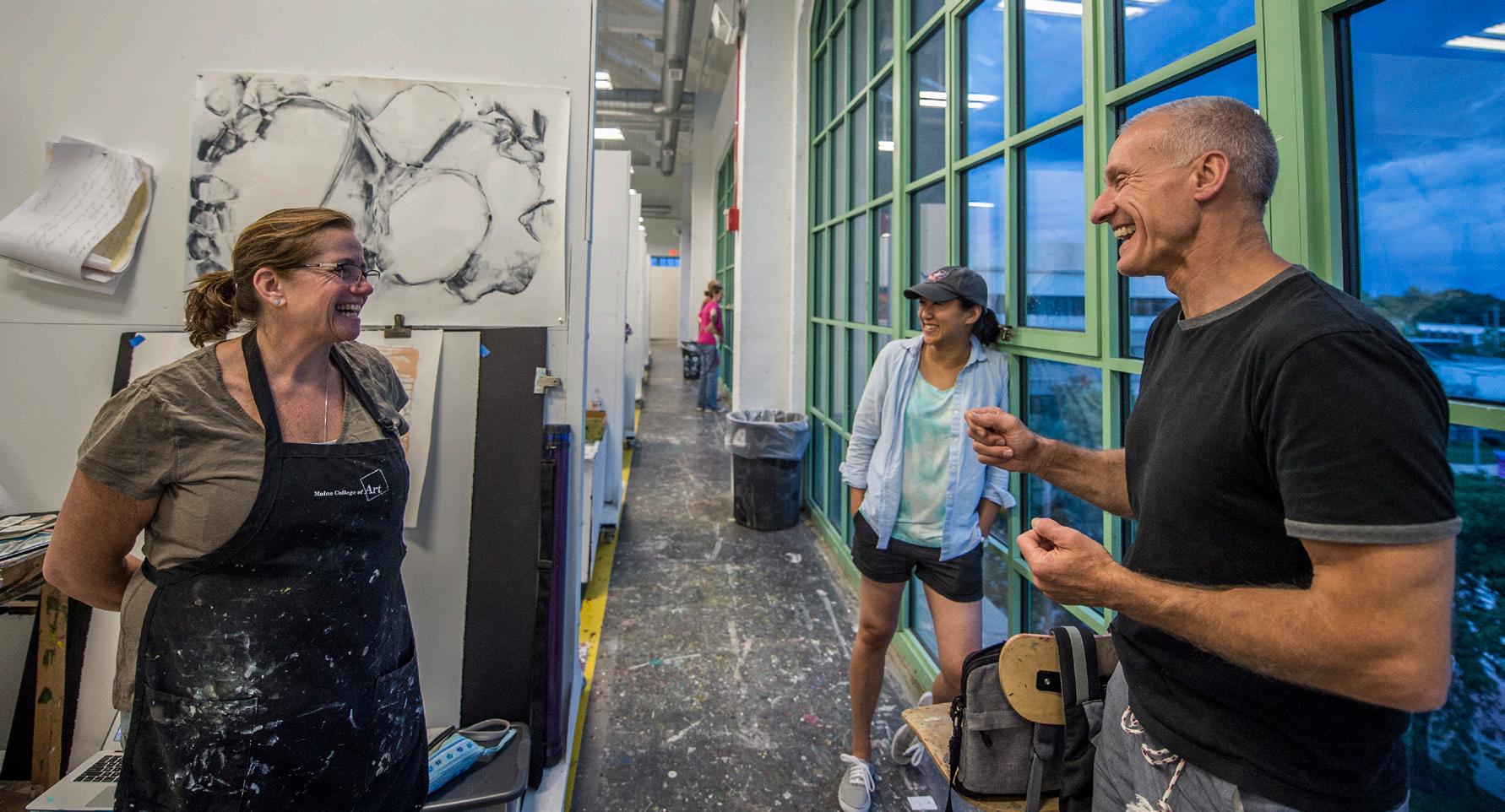
relish immersion into a studio practice away from the daily grind of their teaching commitments. With CIA’s tremendous space and facilities, an environment of supportive camaraderie and a focused goal of artistic growth, the residency is truly inspirational.”
Kristen Cliffel ’90, also a Summer Teaching Residency instructor, believes the program has many strengths. There are CIA’s facilities— “participants feel like a kid in a candy store,” she says—and the lessons they take away. Participants either learn how to teach what they’re learning or how to incorporate it into their own practice, she says. But its biggest strength? The people and the meaningful relationships they forge.
“The beauty of the program is connecting with teachers and artists,” Cliffel says. “It’s built around
Here’s What’s Going On!
Faculty Exhibition
A tradition that spans decades, the Faculty Exhibition is a celebration of art, design and their makers. It remains on view through December 22 in Reinberger Gallery. cia.edu/exhibitions
CIA/Progressive show
Critical Conversations: Art in Practice features student work made in response to work in The Progressive Art Collection. Opens 6–8pm December 9. On view through January 23. cia.edu/events
Scholastic Exhibition
The 2023 Scholastic Art + Writing Exhibition will celebrate the work of students in grades 7–12 in Cuyahoga, Geauga and Lake counties. January 17–February 3 in Reinberger Gallery. cia.edu/events
SIE 77
This year’s Student Independent Exhibition will be on view from February 17 to March 19, 2023 in Reinberger Gallery. Join us for one of CIA’s most treasured traditions. cia.edu/sie77
getting to know each other as artists and building connections, and many continue to communicate and visit each other after the program.”
Schemrich agrees. “For an art teacher who desires to create, or has a desire to be a more effective and meaningful instructor, I would highly recommend this residency,” he says. “Come to learn and create but be ready to make close connections, and feel part of a close art community again as you did in art school!”
The 2023 Summer Teacher Residency takes place June 12–24, with an exhibition of work created during the residency to follow. The application deadline is March 1.
For more information or to apply, visit cia.edu/summer-residency.
Let’s talk about Link
We’re grateful you’re reading this issue of Link! We’re interested in learning more about how you’d like to receive news about CIA alumni and events in the future.
Whether you’re a CIA alum or a friend of CIA, please complete our five-minute survey. cia.edu/link-survey

Increasing pathways leads to enrollment gains
By Yvette Sobky Shaffer
It took me about 30 years after graduating from high school, but I finally am living my dream of joining the community at Cleveland Institute of Art. CIA represented the pinnacle of excellence in art and design education, and it appeared unattainable and elite. Only a few top art students went to art school at all, let alone CIA, and this first-generation student from Brunswick, Ohio was not encouraged to follow the “risky” path of visual art. While it pains me to admit it, the attitudes and stereotypes that permeated in 1990 are not so different now. I consider a primary component of my job to be myth-busting!
Dispelling those art college stereotypes can be as simple as seeing for yourself. We hosted our annual Admitted Student Day in April—the first held in person since the pandemic—and incentivized students to attend by assisting in paying for their transportation expenses. The day was electric! When asked what they most looked forward to in going to CIA in the fall, the word cloud formed in large, colorful fonts, the words “Community,” “Independence” and “Friendship.”
We are hungry for those things, too, and the synergy must have been evident, because 84 percent of the students who attended that event ultimately joined us this fall.
We have made other exciting progress in making this education more accessible and inclusive. We were able to join Say Yes to Education, which provides full funding of tuition and fees for up to five students within the Cleveland Municipal School District. We are also the newest site for College Now, a pre-college after-school program facilitated by the city of Cleveland to assist local students in making the transition from high school to college. Each term, a new cohort of high school students comes to campus to improve their preparation for college, and we couldn’t resist offering them a drawing class, too.
We welcomed our largest class since 2019, with 183 new students on campus this fall. They are
bright eyed and excited to be here. But there are so many more students we can serve if we busted a few more myths. “Unattainable?” “Elitist?” No. We are accessible to every type of student regardless of socio-economic status, gender identity, race or any other box on the form, and these 183 students exemplify that diversity. “Risky?” No. Design thinking and creative problem solving are what we do for breakfast, lunch and dinner. The world needs more of us, not less.
As an alum, you embody that art and design have real impact in the world today. While I sometimes wish someone like me had been there to assist the younger me in getting to CIA 30 years ago, I’m even happier to be that person for others. You are also that person. When you meet that perfect CIA student, encourage them to raise their hand and visit campus or to see us at a local portfolio day.
Thank you for the myth-busting you do every day.
Yvette Sobky Shaffer is Vice President of Enrollment Management + Marketing.

2
Summer Teacher Residency instructor George Kozmon ’82 interacts with participants in CIA’s Painting and Drawing studios.
Pre-orientation program aids first-year students
By Michael C. Butz
First-year Animation student Imani Grant is a Cleveland native and graduate of Lutheran High School East in Cleveland Heights who’s the first in her family to attend a four-year college. She acknowledges she had general apprehension about college as she matriculated at the Cleveland Institute of Art.
“The biggest thing that concerned me was failing my first year and wasting scholarship money and also money paid out of pocket,” she says. “I heard from a lot of people that many first-year students fall into that trap and end up failing the first year. On top of that, I’ve heard horror stories about art schools and how the workload can get kind of heavy.”
In an effort to avoid those pitfalls, Grant enrolled in the Nunes Scholars pre-orientation program, a three-day initiative designed to support incoming BIPOC, LGBTQIA and first-generation students— and other incoming students who might benefit from a more personalized transition into college.

The program has proven valuable for Grant. “Talking with students, especially my mentor and all the other mentors, about their personal experiences at the school helped a lot. They gave me a lot of advice about time management and finding efficient ways to execute assignments.”
Organized by CIA’s Inclusion, Diversity and Equity Awareness (IDEA) Council, the inaugural Nunes Scholars pre-orientation program took place August 16–18, prior to CIA’s traditional orientation for incoming students. Fourteen participants had sessions with academic advisors as well as Financial Aid, Student Accounts and Student Life + Housing staff. Art supplies for the students’ first year were provided, and they learned what classes would be like from a session with interim Foundation chair Kevin Kautenburger.
“We intentionally pointed these students to the resources that would help them be successful academically,” says Jesse Grant, Associate Vice President of Student Affairs + Dean of Students.
In addition, each Nunes Scholars student was paired with a student mentor: Painting junior Janoi Daley, Interior Architecture junior Luca Diaz or Drawing senior ShaDonnah Miller. These partnerships last the entire academic year and provide opportunities for advice, check-ins and studio visits.
Miller, herself a first-generation student from Cleveland Heights High School, recognized the value of serving as a Nunes Scholars mentor. “I’d like to help mentees feel more comfortable on campus and to encourage them to step out of their shells. I remember being a freshman—kind of shy and new to everything—and if I had a mentor, I would’ve functioned a lot better.”
“I feel like having someone who came from the same background as me, or the same race or same financial background as me, and having them say they managed to do it would've inspired me,” Miller adds. “I like being that inspiration for my mentees.”
The impact of the Nunes Scholars pre-orientation program is already being felt. All 14 students earned passing midterm grades and will return to CIA for spring semester, Jesse Grant says, adding that Nunes Scholars students are joining clubs and applying to be orientation leaders, resident assistants or Admissions ambassadors.
He also noted a parallel resurgence of CIA’s identity-based student clubs and organizations, like Latinx Appreciation Club, Color Wheel, and Black Scholars and Artists. “Those things help because they provide students with an opportunity to be in spaces with people who look like them. Representation clearly matters.”
For Imani Grant, lessons learned during the pre-orientation program have continued to pay dividends. “The most valuable part was the knowledge of the school and its environment that I gained in those three days. I’ve been actively trying to apply the advice that the mentors gave me throughout this semester.”
Pawlowski looks back on nearly 60 years at CIA
By Carlo Wolff
It must be strange yet also gratifying to look back on a life of service to the Cleveland Institute of Art. Such reflection is likely to occupy Eugene Pawlowski ’65 at least some of the time, now that he’s retired after virtually a lifetime teaching at his alma mater.
Pawlowski is a Cleveland native who taught graphic design at CIA for 55 years, retiring in July 2021. A graduate of Cleveland Central Catholic High School, he matriculated to CIA and earned a BFA in Graphic Design. He spent his illustrious career inculcating students with traditional values and techniques while at the same time making sure they were up to the technological minute.
Along the way, Pawlowski cut quite an artistic swath himself. He exhibited in Cleveland’s legendary May Show several times. He has been recognized by institutions such as the Cleveland Society of Communicating Arts, New York Art Directors Club, American Institute of Graphic Arts, and the Society of Illustrators. His freelance work has been extensive, with clients ranging from Blue Cross/Blue Shield to Progressive, Cleveland Clinic to CIA itself.
He designed the current CIA logo. He detailed his design approach in a 1986 issue of Link
“I looked closely at the institute’s mission, and I felt strongly that what we try to do (at CIA) is produce a person who is very well-rounded, people who
are able to think, analyze, express feelings in a physical way, with their hands,” he said. “I was trying to express the feeling that people here deal with the mind, the eye and the heart in doing what they do.”
Pawlowski taught and developed coursework in Handmade Book, Typography, Visual Communication, and Design and Production, making sure the graphic design curriculum kept pace with the times as they shifted to digital.

Despite his embrace of the new, Pawlowski never lost sight of the foundations of graphic design. Fundamentals were his favorites.
“The part I liked best was teaching Graphic Design students typography and how to deal with the history of typesetting,” he said in August. Even though today’s students use computers, Pawlowski added, “I thought they should have a foundation in the beginnings of letter forms. That’s what I kind of valued most—getting them to appreciate that.”
Pawlowski earned the Schreckengost Award for Teaching Excellence in 2007. What he liked most about teaching was interacting with students. What advice does he have for them in retirement?
“Work really hard, which I think most students are doing,” he says. “I would encourage them to go all out in what they’re doing. Because when they get out into the real world, they’re going to be fighting some pretty serious talent.”
What did he learn from his students over five decades in the classroom?
“How to be a good person. Most of those kids are really very open about their relationships with each other—and how they interact with one another.”
3
Imani Grant, eighth from left, gathers with the inaugural cohort of Nunes Scholars pre-orientation program students for a group photo on August 18 in CIA's Mary Ann and Jack Katzenmeyer Student Lounge. Photo by Leah Trznadel ’19.
Eugene Pawlowski ’65 testing a variety of logo iterations on the CIA letterpress.
Faculty Gutierrez, Wulffen work on global stage
By Carlo Wolff
When Foundation faculty member Steven Gutierrez was asked to participate in Imaginarius, his response was an enthusiastic “yes.” His eagerness to be part of Portugal’s largest street arts celebration landed this conceptual, multimedia artist and his striking installation in the city of Santa Maria da Feira for four days in May. What Gutierrez brought back to Cleveland Institute of Art, where he has taught for the past six years, was a newly informed approach to art.
This sentence fragment in the Imaginarius solicitation particularly intrigued Gutierrez: “… exploring new connections between different languages and cultural/natural heritage.”
“In this context, my goal was to make a piece that had a universal language,” he explains. “I focused on the visual language of art to explore the connection between a new country with its own language, different people in that country, and myself. By making a sculpture that the user can control, I allowed anyone to ‘speak’ their feelings through this simple sculpture that uses 3D space movement and colored LED lights for expression.”
His installation, “Gibberish not Gibberish,” consisted of translucent blocks that could be manipulated to change color and arrangement.
For a spell, Gutierrez had to stand by “Gibberish” in case a passerby wanted to inquire about it, talk about what it meant—or try it out: “It was really about expressing yourself through these translucent white blocks that rotate depending on how you move the knobs on a box almost like a volume controller.”
Because he set up early—a practice Gutierrez intends to encourage in his students—he had time to explore the city and absorb a cultural happening that reminded him of Ingenuity Festival, an annual Cleveland event designed
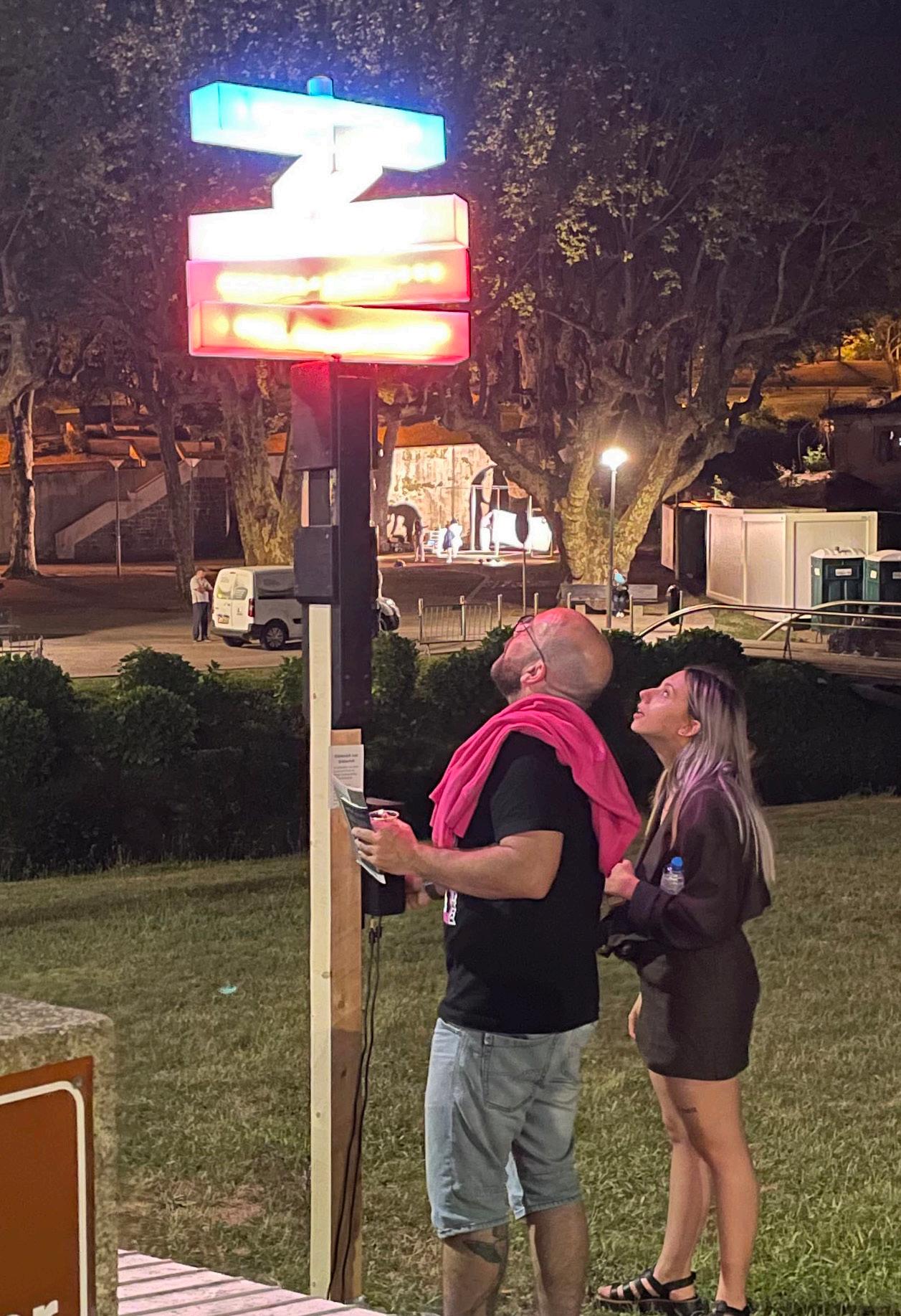
Continued from page 1
School could be bumpy, but the struggles proved productive. “I took a semester of car design while at CIA and got my butt kicked,” says TsaiMcCarthy. Despite that, that class helped him design the Ford Explorer for the LEGO Jurassic Park set as well as the truck from the Jurassic World Dominion triceratops set.
“Even though that class did a number on me, it did give me what I needed to interpret the ’93 Explorer’s shapes,” says Tsai-McCarthy.
“The best toys will have a unique story, come from intellectual property-assisted stories (such as Marvel and Star Wars), or give the user the ability to tell their own story,” says Tsai-McCarthy, who lives in Billund, Denmark, LEGO’s company town.
Toys are an education unto themselves, he says. “In the early years, toys are great for developing important gross, emotional and social skills. Then, as the child becomes more self-sufficient, toys become incredibly important for expression, where users can tell their own stories, form their own conclusions.”
A different breed Perme and Lees host an unusual menagerie in their home in Cleveland’s Tremont neighborhood. Their separate studios are dedicated to Horrible Adorables, the fantasy creatures they’ve been creating for more than a decade.
As a child, Perme preferred playing with toy animals rather than dolls. Now, she’s happy to develop quirky toy animals that appeal to kids and to produce toys that attract adult collectors
to celebrate the fruitful symbiosis of art and technology.
At Imaginarius, Gutierrez says he “learned a lot about performance art and the value that Portugal and other European countries place on contemporary circus, dance and theater. I was impressed with the creativity and unique ways that artist presented their work. Besides exposing current students to some of this existing work, and sharing my creative process, I would imagine that I might one day invite some of their performers to discuss their process with our students.”
Another globe-trotting artist is Foundation faculty member Christian Wulffen. To him, teaching and art are two sides of the same coin.
“The transparency I like to achieve in my exhibitions is challenging me for transparency in my teaching methods,” he says. “The audience can be involved and participate, and the students, too. Transparency, participation and involvement belong together for me. I learned a lot about that in my teaching of nearly 19 years at CIA.”
He also learned about cultural variety by mounting exhibitions here and abroad, like Ich/ Du, a solo show that opened at Galerie Sturm & Schober in Vienna in November 2021. Working with galleries in various European countries schooled Wulffen in cultural diversity and made him feel part of an artistic community that transcends geography.
“There are differences in cultures in Europe, but then there is the international network in the infrastructure of art,” he says. “This is the driving power: how differences are rather a potential of conversations without boundaries.”
Explore, he advises students. If possible, reconnoiter the country where you would like to exhibit, learn at least some of its language, and
as well. For her, the creative process is the through-line, the satisfaction.
Perme often works on concepts that don’t progress, but she’s proud when they click. Securing a deal to produce a line for the designer toy producer Kidrobot felt like a global breakthrough.
Take Pufferhedge, a 12-legged toy that melds hedgehog, dinosaur and pufferfish. It seems friendly, but the glossy felt scales wrapped around its frame feel aggressive. And it sports a horn.
On a more adult, art-collector level, there’s Polka Smok-Damazy, a fiercely beautiful wall hanging based on Polish dragon legend. This mash-up’s wings are made of vintage fabric, but it bears contemporary polymer clay fangs. The stare from its glass eyes make it a scary household guardian.
“Many times, things I work on are developmental concepts that don’t always make it to the shelves, or the final product becomes so altered I don’t see my artwork in them anymore,” she says. “It’s OK, though, because I enjoy having a small part in the creation of something big and world-recognized. It’s also part of the reason why I have another creative outlet in designer toys, where Chris and I have total control over what we produce.”
Horrible Adorables is an outgrowth of the soft sculptures Perme was creating in Fiber + Material Studies at CIA. “I felt very free in my chosen major to pursue character-driven artwork that was a bit odd and nontraditional, and I had a great support system to do it,” she says. “Once
reach out to institutions and people there that can help you realize your ambitions.
Though he’s retiring in December, Wulffen is far from done. He plans to create one installation or exhibition each year and is interested in collaborations with artists from different backgrounds. If anything, his footprint will expand.
“London, Stuttgart, Reutlingen and Vienna will be my places,” he says, along with some “new cities.” Cleveland and Los Angeles, too, will be bases for his activities.
“Different cultures, different approaches, learning and transferring,” Wulffen muses. “What a chance.”
Toy design career advice
José Longoria ’81, John Boyce ’95, Grady Hayes ’04, Art Hamling ’05, Tim Hayes ’07, Jordan Perme ’09 and former CIA student Christopher Lees, Atticus Tsai-McCarthy ’16, and Erica Lerchbacker Kraus ’19 are all successful toy designers. Learn what they think is important to know about about a career in toy design by visiting cia.edu/news
Chris and I started working together and achieved success with that side of the business, it was a natural progression to translate the characters we were constructing from felt and textiles into actual toys.”
Toy design combines technical, aesthetic and emotional skills, Lees says.
“Having a good understanding of mold-making, casting and other toy manufacturing processes are critical building blocks to good toy design. The next step is creating a concept that fits within those manufacturing constraints. All this has to be executed with current and past trends in mind while directing what emotion the design will evoke—usually a sense of fun or playfulness.”
“Play is absolutely pivotal to me and my artwork,” says Perme. “With the work Chris and I produce for Horrible Adorables, we strive to make our art as approachable and accessible as possible. We can best achieve that by creating objects that are playful. Once you scratch the surface, a deeper meaning often emerges from our artwork … but we have to draw people in first so they will look long enough to discover what it is.”
4
Viewers take in Steven Gutierrez’s “Gibberish not Gibberish” during Imaginarius in Portugal. Submitted photo.
link@cia.edu
Bernice Kochan ’48 is the author and illustrator of her first children’s book, How Santa Became a Toymaker: ChristmasLore Retold, published in August 2022.
Harold Zisla ’50 * is the subject of “Gesture,” a newly launched quarterly newsletter focused on his art and legacy. Visit haroldzisla.com to subscribe.
Ron Testa ’65 had work in Grayscale: A Picture Show at Black Box Gallery in Portland, Oregon and in Visions of Photography: Stories of Now at Colonel Eugene Myers Gallery at the University of North Dakota in Grand Forks, North Dakota.
Bruce McCombs ’66 had a solo show Bruce McCombs: City Journeys at the Muskegon Museum of Art in Muskegon, Michigan.
David Deming ’67 was commissioned to create a bronzed sculpture honoring longtime stadium drummer for the Cleveland Guardians, John Adams.
Debrah Butler ’74 showed work in the 86th National Midyear Exhibition at the Butler Institute of American Art in Youngstown, Ohio; the 46th Annual Juried Exhibition at the Fairmount Center for the Arts in Russell Township, Ohio and the 20th Annual Kaleidoscope Juried Exhibition at Summit Art Space in Akron, Ohio.
Richard Heipp ’76 had a solo show, Museum Reflections: Artists, Devils and Saints, at Valdosta State University’s Maranville Art Gallery in Valdosta, Georgia.
Babs Reingold ’78 had work in Address: Earth at Hudson Valley MOCA in Peekskill, New York.
Susan Breitsch ’82 was recently awarded the Tree of Life Artist Grant.
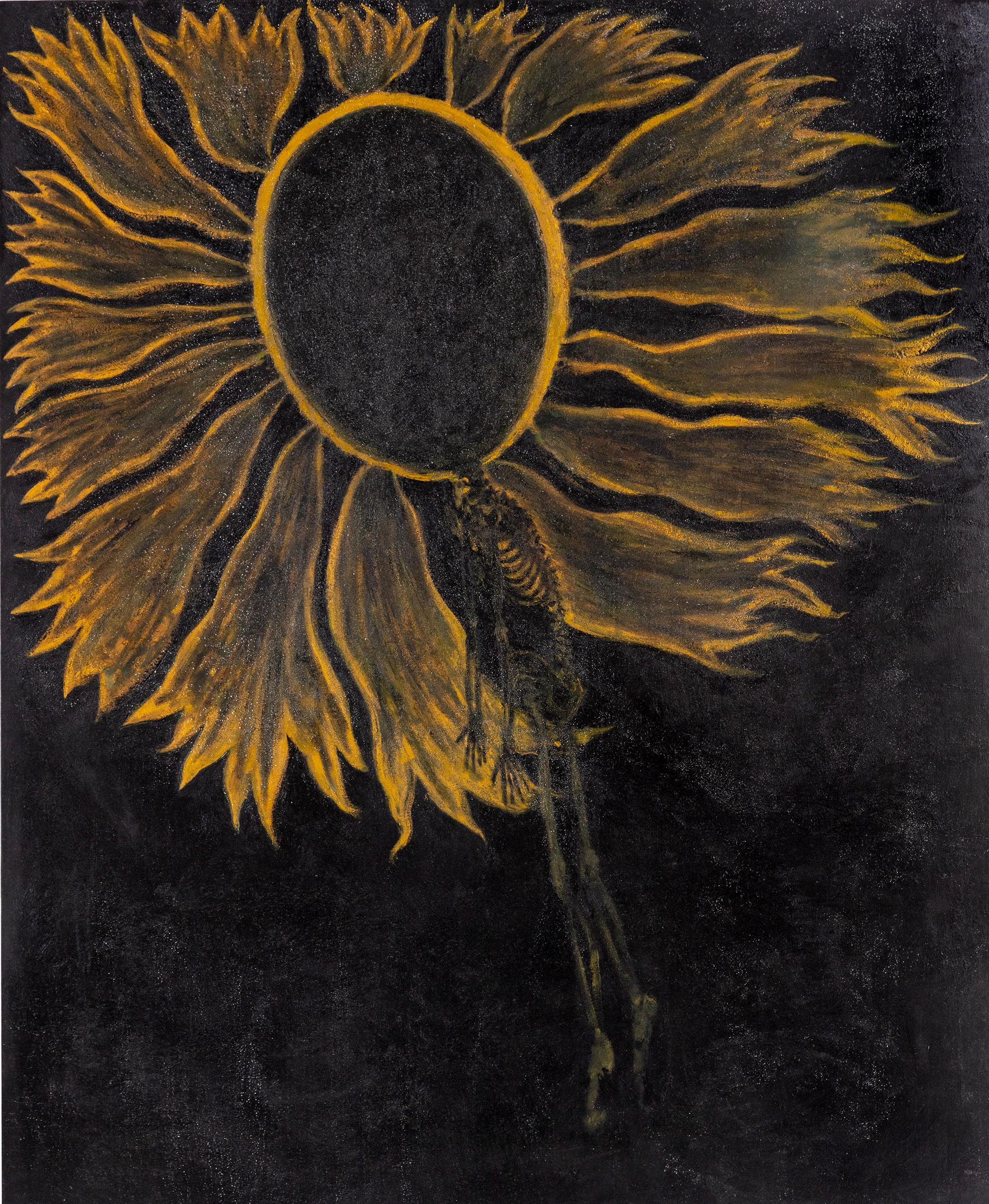
William Moore ’84 had work at Art San Diego at the San Diego Convention Center. Moore will also show work in Art Comes Alive 2022 at Art Design Consultants in Cincinnati through December 30.
Stanka Kordic ’85 had work in Blurred Lines and Hazy Intent at Bowersock Gallery in Provincetown, Massachusetts.
Judy Takács ’86 has work in the 2022 Art of the Heartland National Competition at Mena Gallery in Mena, Arkansas; Allied Artists of America 109th Annual Juried Exhibition at The Butler Institute of American Art in Youngstown, Ohio; the Catharine Lorillard Wolfe 125th Annual Juried Associates and Members Show at Ridgewood Art Institute in Ridgewood, New Jersey; the Paul and Norma Tikkanen Painting Prize at the Ashtabula Arts Center in Ashtabula, Ohio and at Cleveland Hopkins International Airport.
Linda Zolten Wood ’87 was recently interviewed by WKYC in Cleveland, where she discussed the Collinwood Painted Rain Barrel Project.
Dexter Davis ’90 was featured on an episode of Applause with Cleveland’s Ideastream.
Valerie Marek ’91 had work in Nearly White at the Artists Living Room in New York City.
Yuko Kimura ’94 showed print work in Cosmic Collages as part of the 2022 Fulcrum Arts Festival in Los Angeles.
Kevin Snipes ’94 had work in In the Round: Vessels and Sculpture from RAM’s Collection at Racine Art Museum in Racine, Wisconsin.
Jeanetta Ho ’96 had work in The 46th Annual Fairmount Art Exhibition at Fairmount Center for the Arts in Russell Township, Ohio and in Imagination at Heights Arts in Cleveland Heights, Ohio. Imagination also had work from Julianne Edberg ’76 and Yiyun Chen ’15

Libby Black ’99 had a solo show, The Way Things Also Are, at 500 Capp Street Foundation in San Francisco.
Timothy Callaghan ’99 and Karen Sandstrom ’12 had work installed at the Geauga County Public Library’s Bainbridge Township branch.
Amy Casey ’99 had a solo exhibition, Continued Continuing: Paintings by Amy Casey, at the Canton Museum of Art in Canton, Ohio.
Heinrich Toh ’00 discussed his work in an interview with IN Kansas City
Branden Koch ’01 had work in solo show, Heavy Light, at Bunker Projects in Pittsburgh.
Thaddeus Wolfe ’02 had work in a joint solo exhibition with Friedman Benda in New York.
Alison O’Daniel ’03 was named a Ford Foundation 2022 Disability Futures Fellow.
Courtenay Finn ’05 discussed the opening of the Orange County Museum of Art and her curatorial role with The Orange County Register
Charmaine Spencer ’05 and Erykah Townsend ’20 were named as two of the inaugural recipients of the FRONT Art Futures Fellowship.
Mark Reigelman ’06 had his public art project—“The Makers Monument” in Columbus, Ohio—ranked in the top 100 public art projects in the world by CODAworx as part of the 2022 CODAawards.
5
Have a note to share? Please submit by February 6 to
for inclusion in the next issue of Link.
Braden Koch ’48
Valerie Marek ’91
Tim Hayes ’07, founder and CEO of Cardboard Helicopter in Cleveland, designed the NERF Paddlepong and the NERF Spiral Grip Football.
Julianna Miller ’07 was recently named Design Director of Smart Design in New York City.
Anthony Zart ’08 had a pop-up show, What Do We Know About Margaret, at Biographie Studio in Lakewood, Ohio.
Josh Greiner ’09 designed the interior of the newest Ford Mustang.
Georgio Sabino III ’09 had work in the Community Art Show sponsored and hosted by the GAR Foundation in Akron, Ohio.
Lauren Yeager ’09 had a solo exhibition, Longevity, with Abattoir Gallery in Cleveland.
Ashley Pastore ’10 has work in Alter/Altar at Allegheny Art Galleries in Meadville, Pennsylvania.
Leigh Brooklyn ’11 had a solo show, All of Me, at Kaiser Gallery in Cleveland’s Tremont neighborhood.
Ben Wilkins ’13 and Liz Wilkins ’12 were featured in a Newsweek article, “Families Are the Beating Heart of Today’s Auto Industry.”
Rachel Yurkovich ’14 had a solo show, Are You Civilized to Death?, at Waterloo Arts in Cleveland.
Kimberly Chapman ’17, has her traveling exhibition, Eighty-Six Reasons for Asylum Admission, on view at Erie Art Museum through May 14. Her feature article, “Out of the White Cube,” was recently published in Ceramics Monthly Magazine
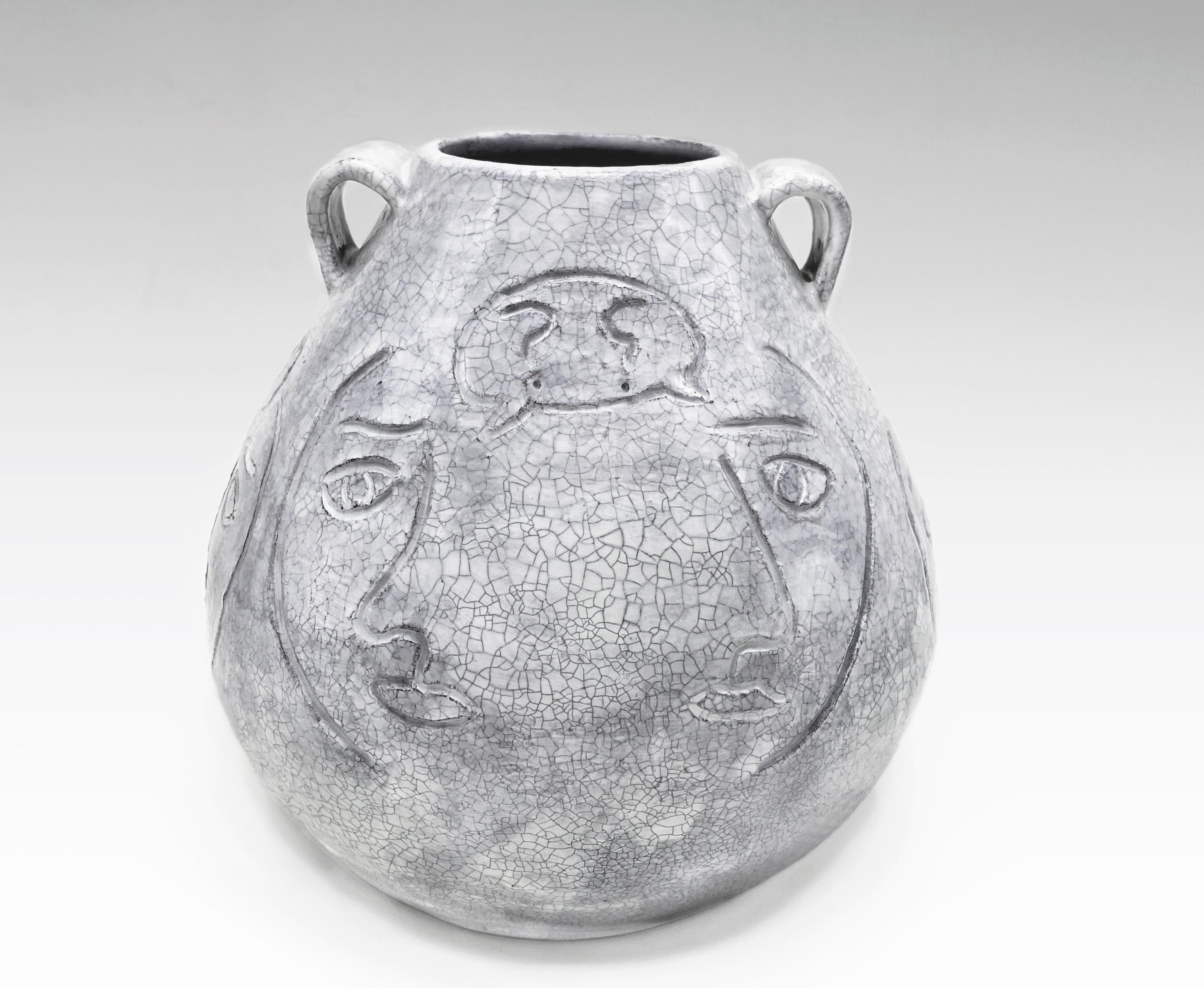
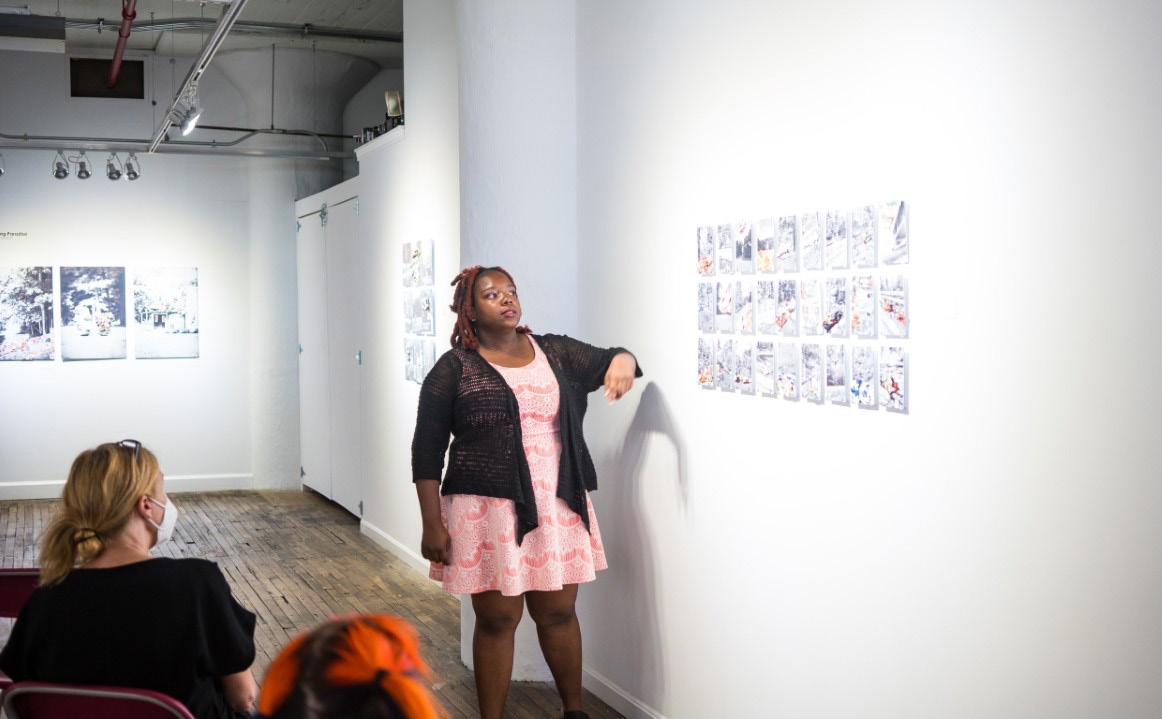
Cass Penegor ’20 co-curated Rituals at Cain Park’s Feinberg Art Gallery in Cleveland Heights, Ohio.
Kate Stewart ’20 shared her journey as an upand-coming young illustrator in an interview for Voyage Ohio Magazine
Justin Freeman ’21 was selected to show his short film, Sweet Life, in its fourth festival, Black Film Fest Atlanta.
Violet Maimbourg ’21 had work in the 16th annual HWD Juried Sculpture Exhibition at Rosewood Gallery in Kettering, Ohio and in TASC at Hand 2022 at The Muse Gallery as part of The Artist Support Centre in London. Maimbourg will take part in an artist residency with arteventura in Spain in 2023, as well as a virtual residency with School of Visual Arts in New York.
Maxmillian Peralta ’21 was commissioned to create a portrait of LeBron James. The portrait was featured on the cover of the inaugural magazine by James’ SpringHill Company.
Madeline Davis ’22 was awarded Best In Show in the Grand Exhibition Art Competition: Embodying Masonic Values 2022 in Philadelphia.
Arts Leadership Residency: Valerie Mayen ’05, Charmaine Spencer ’05, Kayli Salzano ’18 and Erykah Townsend ’20 were announced as members of the 2022–23 Arts Leadership Residency Cohort by Assembly for the Arts in Cleveland.
SPACES Satellite Fund: Valerie Mayen ’05, Scott Goss ’06, Toby Griffiths ’14, Amber N. Ford ’16 and Alyssa Lizzini ’22 were all selected to receive Satellite Fund awards from SPACES in Cleveland.
Orlando Caraballo ’18 has been named the McDonough Emerging Artist for this fall at the McDonough Museum of Art at Youngstown State University. A solo exhibition, Capicú, was on view at the museum.
Kelly Pontoni ’19 curated Queer Pulse...The Ripple Effect at The Gallery at Lakeland Community College in Kirtland, Ohio. Featured artists included Mark Howard ’86, Karen D. Beckwith ’87 and Sam Butler ’19
Obituaries
Sydney Nicole Kay ’21 had work in The 2021 Bivens Fellowship: Camilo González Barragán and Sydney Nicole Kay at the Cleveland Print Room.
Seneca Kuchar ’21 had a solo show, On Blocks: Repair Manual for an American Dream at Waterloo Arts in Cleveland.
Short Listed: Thank you to Mark Tekushan ’79, Kevin Geiger ’89, Michael Schmidt ’04, Andrew Zimbelman ’06 Ashley Gerst ’07 Albert McClelland ’10, Rachel Yurkovich ’14, Sam Butler ’19, Charlie Rose ’20, Liam Darby ’21, Kelsey Bishop ’22 , Madelyn Brooks ’22 , Grace LaPrade ’22 , Anthony Liotta ’22 , Celeste Moore ’22 Sunny Podbelsek ’22 and Lauren Radaker ’22 for participating in Short Listed: The CIA 2022 Alumni Short Film Exhibition. Schmidt, Rose and Yurkovich won first-, second- and thirdplace prizes, respectively.
6
Starkey Hoot ’49 passed away July 26. He majored in Industrial Design.
Peter Marks ’66 died October 20. He studied Graphic Design.
Dwight Wooters ’67 died September 4. He was an Industrial Design major.
Thomas Fink ’72 passed away July 27. He was a Photography major.
Beatrice Mitchell ’80 died October 12. She majored in Sculpture.
Madeline Davis ’22
*Deceased
Sydney Nicole Kay ’21
Faculty and Staff Notes
Colby Chamberlain (Liberal Arts) published an essay on Cleveland’s FRONT Triennial in the November issue of Artforum. His book, Fluxus Administration, is forthcoming from the University of Chicago Press.

Maggie Denk-Leigh (Printmaking) represented Cleveland organizations in the Mid-American Print Council (MAPC) conference, The Power of Print, in October and organized CIA’s on-campus involvement. Also, she had work selected by LAND studio into the MetroHealth Glick Center Art Collection. She’s an invited artist for Cleveland Prints, which opens November 17 at Cuyahoga Community College’s Eastern Campus in Highland Hills, Ohio. She also worked with CIA Printmaking majors Layla Harris Arfil Pajarillaga, Gwen Putz and Lilly Ross on a 4x6-foot collaborative wood relief block to be printed during Big Ink, November 5–6 at Baldwin Wallace University in Berea, Ohio.
Scott Goss ’06 (Foundation) received a Satellite Fund Grant from the Andy Warhol Foundation in New York City, which is distributed through SPACES in Cleveland. This grant will fund new work that explores the rise and fall of cities over time and invokes questions about our environment, fair and equitable housing, and entropy.
Steven Gutierrez (Foundation) was accepted as the 2022 resident at the Alpena Wildlife Sanctuary in Alpena, Michigan. He spent his residency focused on the invasive species of the region.
Elizabeth Hoag (Liberal Arts) participated in Archaeology Day at the Shaker Historical Society museum, which featured archaeologists from the Cleveland Museum of Natural History and Summit County Metroparks. She also organized and ran the fall meeting/conference of the Ohio Archaeological Council in Columbus, Ohio. In addition, she traveled to Lexington, Kentucky to participate in the first Bluegrass Annual Discussion on Anthropology and Social Sciences, where she presented on her research, “Resilience and Empowerment: One Hundred Years of Archaeological Mothers in the Field.”
Benjamin Johnson (Craft + Design) had a solo exhibition, Apparent Horizons, on view in October at Glass Axis in Columbus, Ohio. In addition, he conducted a demonstration—with assistance from CIA Glass students—during a public reception for the show on October 14.
Natalie Lanese ’05 (Foundation) completed a new public work, “Glacier Caves,” in September at the intersection of West 25th Street at Walton Avenue in Cleveland’s Clark-Fulton neighborhood.
Scott Lax (Liberal Arts) had his play, 1970 selected to make its world premiere September 22–24 and September 29–October 1, 2023 at Chagrin Valley Little Theatre in Chagrin Falls, Ohio. The play—which is based on his novel, The Year That Trembled—will serve as the seasonopening mainstage play for CVLT’s 93rd season.
Pete Maric ’00 (Interior Architecture) recently completed renderings for The Shoreby Club in Bratenahl, Ohio in collaboration with Marous Brothers and Joseph L. Myers Architects.
Julie Schenkelberg (Foundation) has a solo exhibition, Currant, on view through December 16 at The Sculpture Center in Cleveland. She is The Sculpture Center’s first artist-in-residence and was the first artist to show in its newly acquired space at 12210 Euclid Ave.
Gerry Shamray (Foundation) was listed in the acknowledgements for Drew Friedman’s new book, Maverix and Lunatix: Icons of Underground Comix
Barry Underwood (Photography + Video) will be a visiting artist at Sonoma State University in Rohnert Park, California, as part of the university’s Visiting Artists’ Lecture Series.

Meghan Wagner (Liberal Arts) had a short story, “Elephant Seals,” included in this year’s The Best American Short Stories 2022. Another short story, “Save Yourself: A Limited Original Series,” will appear in Story #15 at the end of November.
Nikki Woods ’12 (Reinberger Gallery) organized a group exhibition, A Painters Table, with fellow exhibiting artists Katy Richards ’11 and Corrie Slawson. The show was on view from October 7 to November 12 at Waterloo Arts in Cleveland. Her work was also on view in The Regional through September 11 at the Kemper Museum in Kansas City, Missouri.
Allison Hall (Foundation) had one piece in the CAN Triennial this past summer and was named a winner of an Exhibition Prize by BayArts in Bay Village, Ohio. She also had work in The Paul and Norma Tikkanen Painting Prize Exhibition at the Ashtabula Arts Center in Ashtabula, Ohio. Her work can also be viewed during the Holiday Market and open studio event December 16–18 at the Screw Factory in Lakewood, Ohio.
David Hart PhD (Liberal Arts) had his article, “Spoken Softly with Mama: Memory, Monuments, and Black Women’s Spaces in Cuba,” published in the fall 2022 issue of RACAR: Revue d’art canadienne/Canadian Art Review, a peerreviewed journal of the Universities Art Association of Canada.
Ambreen Hasan (Academic Affairs) presented “Leveraging Power BI in Higher Education” on October 21 at the Ohio Association of Institutional Research and Planning conference in Columbus, Ohio.
Deborah Pinter ’88 (Photography + Video) had a piece from her Luminous Florals series permanently put on display at the new MetroHealth Glick Center in Cleveland. In addition, she participated in the Big Ink event November 5–6 at Baldwin Wallace University in Berea, Ohio. The work will then be displayed at Baldwin Wallace’s Kleist Center of Art and Drama through December 2.
Robert Roth (Illustration) had one of his landscape paintings, “Marsh Break,” acquired by Harper Collins Publishers. In addition, it was licensed through his gallery for cover rights to the upcoming book Every Woman A Theologian by Phylicia Masonheimer.
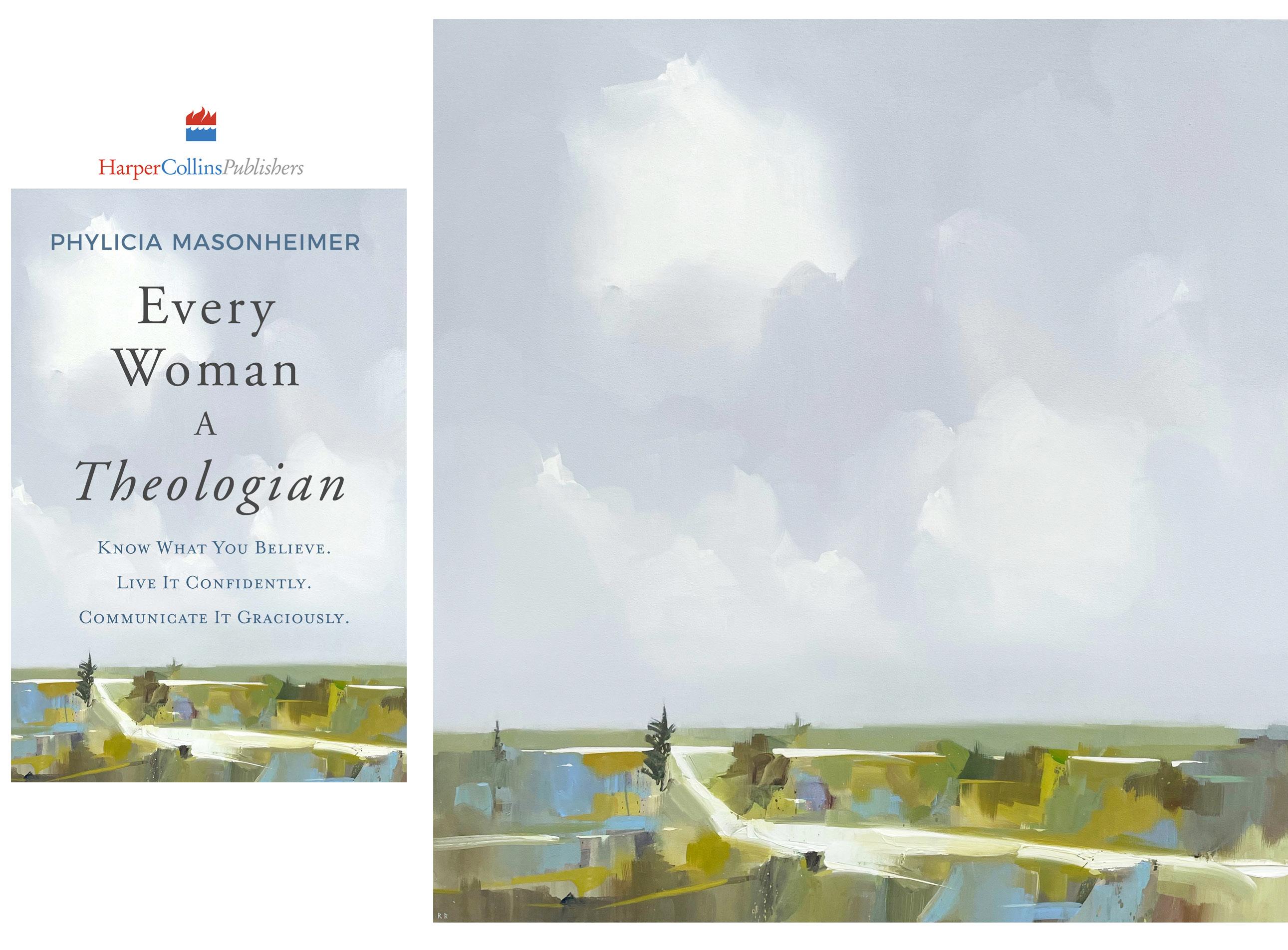
Zach Savich (Liberal Arts) had a critical essay, “Roethke’s Notes,” published in the Fall 2022 issue of the Georgia Review. A series of new poems appeared in the literary arts journal A Dozen Nothing
Brent Kee Young (Emeritus) had his “Whacky Slantindicular....” from his Matrix Series acquired by the Imagine Museum in St. Petersburg, Florida.
7
Anthony Scalmato ’07 (Animation) worked on the production of the Jacquie Lawson 2022 Sussex Advent Calendar. He contributed to animating and illustrating several vignettes as the days countdown to Christmas.
Robert Roth
Deborah Pinter ’88
Allison Hall
of Art + Design




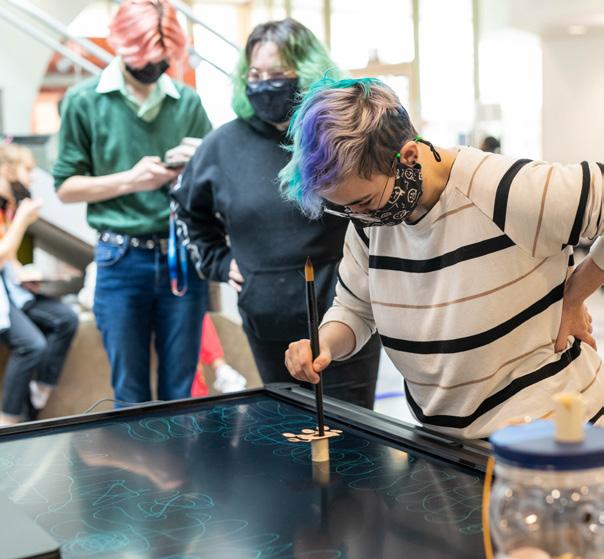
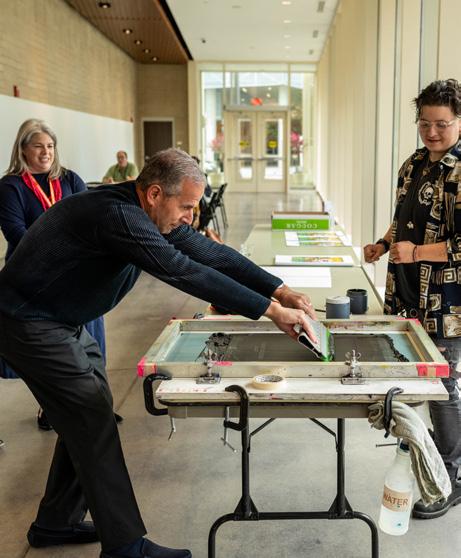
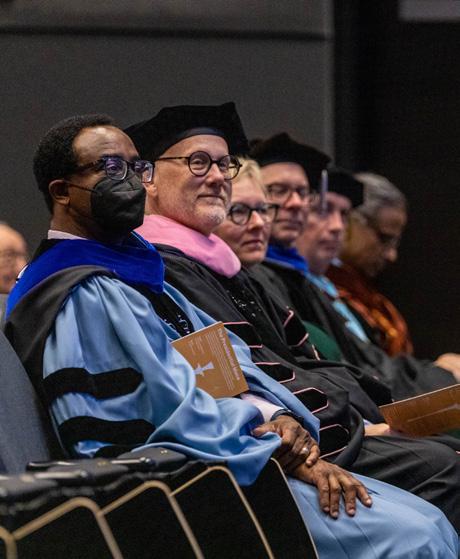

8 Link Link
Helping alumni and friends of the Cleveland Institute of Art remain informed of campus, faculty and alumni news. CIA publishes Link three times a year. Copyright © 2022 Cleveland Institute of Art Connect with CIA Submit ideas and updates for Link : By mail: Cleveland Institute of Art 11610 Euclid Avenue Cleveland, OH 44106 By email: link@cia.edu By phone: 216.421.7412
The Cleveland Institute of Art gratefully acknowledges the citizens of Cuyahoga County for their support through Cuyahoga Arts & Culture.
J.
+ CEO Vol. 26, Issue 2 Winter 2022
Kathryn
Heidemann President
President + CEO Kathryn J. Heidemann’s new tenure was formally celebrated during an investiture ceremony on September 23. The program included remarks and events.
Photos by Amber N. Ford ’16.
Winter 2022 News
Inauguration Celebration Investiture Ceremony
for
Alumni and Friends of the Cleveland Institute of Art
Malou Monago Vice President of Institutional Advancement
+ External Relations
Michael C. Butz Director of College Communications
+ External Relations
Alexandra Burrage Director of Alumni Relations + Scholarships
Brittney
Esther Graphic Design + Communications Specialist
@cleinstituteart
Cleveland Institute of Art College
From left to right, Rachel Shelton ’11, Rebekah Wilhelm ’09, Karen Beckwith ’87, Xander Ristofski ’22, Kelly Pontoni ’19, Brooke Inman ’06, Printmaking Chair Maggie Denk-Leigh, Rachel Moell ’19 and Julia Milbrandt ’19 all attended We Want More, a pop-up exhibition presented in conjunction with the Mid America Print Council’s The Power of Print conference October 14–16 in Reinberger Gallery.
Photo by Leah Trznadel ’19.






















